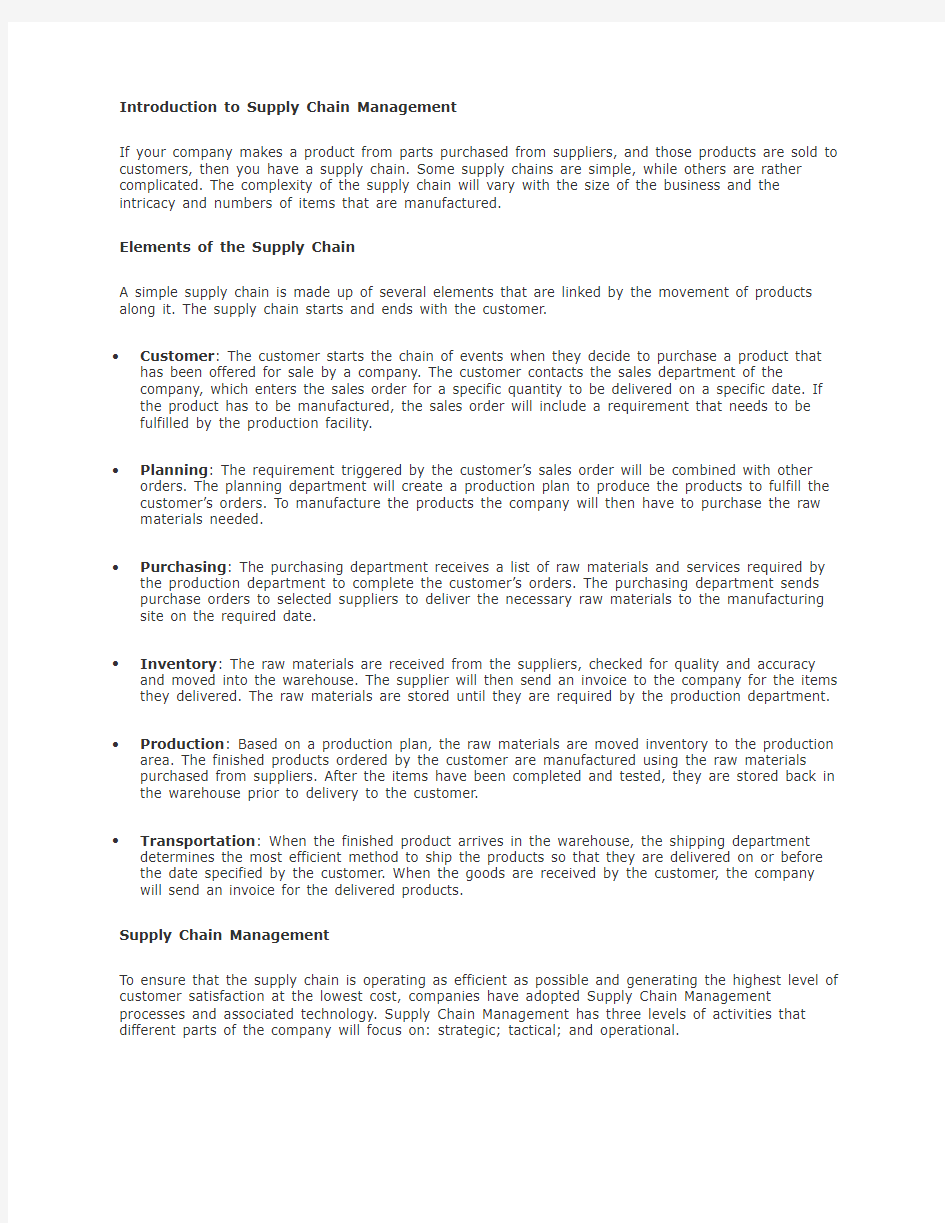Introduction to Supply Chain Management


Introduction to Supply Chain Management
If your company makes a product from parts purchased from suppliers, and those products are sold to customers, then you have a supply chain. Some supply chains are simple, while others are rather complicated. The complexity of the supply chain will vary with the size of the business and the intricacy and numbers of items that are manufactured.
Elements of the Supply Chain
A simple supply chain is made up of several elements that are linked by the movement of products along it. The supply chain starts and ends with the customer.
?Customer: The customer starts the chain of events when they decide to purchase a product that has been offered for sale by a company. The customer contacts the sales department of the
company, which enters the sales order for a specific quantity to be delivered on a specific date. If the product has to be manufactured, the sales order will include a requirement that needs to be fulfilled by the production facility.
?Planning: The requirement tr iggered by the customer’s sales order will be combined with other orders. The planning department will create a production plan to produce the products to fulfill the customer’s orders. To manufacture the products the company will then have to purchase the raw materials needed.
?Purchasing: The purchasing department receives a list of raw materials and services required by the production department to complete the customer’s orders. The purchasing department sends purchase orders to selected suppliers to deliver the necessary raw materials to the manufacturing site on the required date.
?Inventory: The raw materials are received from the suppliers, checked for quality and accuracy and moved into the warehouse. The supplier will then send an invoice to the company for the items they delivered. The raw materials are stored until they are required by the production department.
?Production: Based on a production plan, the raw materials are moved inventory to the production area. The finished products ordered by the customer are manufactured using the raw materials purchased from suppliers. After the items have been completed and tested, they are stored back in the warehouse prior to delivery to the customer.
?Transportation: When the finished product arrives in the warehouse, the shipping department determines the most efficient method to ship the products so that they are delivered on or before the date specified by the customer. When the goods are received by the customer, the company will send an invoice for the delivered products.
Supply Chain Management
To ensure that the supply chain is operating as efficient as possible and generating the highest level of customer satisfaction at the lowest cost, companies have adopted Supply Chain Management processes and associated technology. Supply Chain Management has three levels of activities that different parts of the company will focus on: strategic; tactical; and operational.
?Strategic: At this level, company management will be looking to high level strategic decisions concerning the whole organization, such as the size and location of manufacturing sites,
partnerships with suppliers, products to be manufactured and sales markets.
?Tactical: Tactical decisions focus on adopting measures that will produce cost benefits such as using industry best practices, developing a purchasing strategy with favored suppliers, working with logistics companies to develop cost effect transportation and developing warehouse strategies to reduce the cost of storing inventory.
?Operational: Decisions at this level are made each day in businesses that affect how the products move along the supply chain. Operational decisions involve making schedule changes to production, purchasing agreements with suppliers, taking orders from customers and moving products in the warehouse.
Supply Chain Management Technology
If a company expects to achieve benefits from their supply chain management process, they will require some level of investment in technology. The backbone for many large companies has been the vastly expensive Enterprise Resource Planning (ERP) suites, such as SAP and Oracle. These enterprise software implementations will encompass a company’s entire supply chain, from purchasing of raw materials to warranty service of items sold. The complexity of these applications does require a significant cost, not only a monetary cost, but the time and resources required to successfully implement an enterprise wide solution. Buy-in by senior management and adequate training of personnel is key to the success of the implementation. There are now many ERP solutions to choose from and it is important to select one which fits the overall needs of a company’s supply chain.
Since the wide adoption of Internet technologies, all businesses can take advantage of Web-based software and Internet communications. Instant communication between vendors and customers allows for timely updates of information, which is key in management of the supply chain.
From https://www.wendangku.net/doc/3419099236.html,/od/supplychainintroduction/a/into_scm.htm
